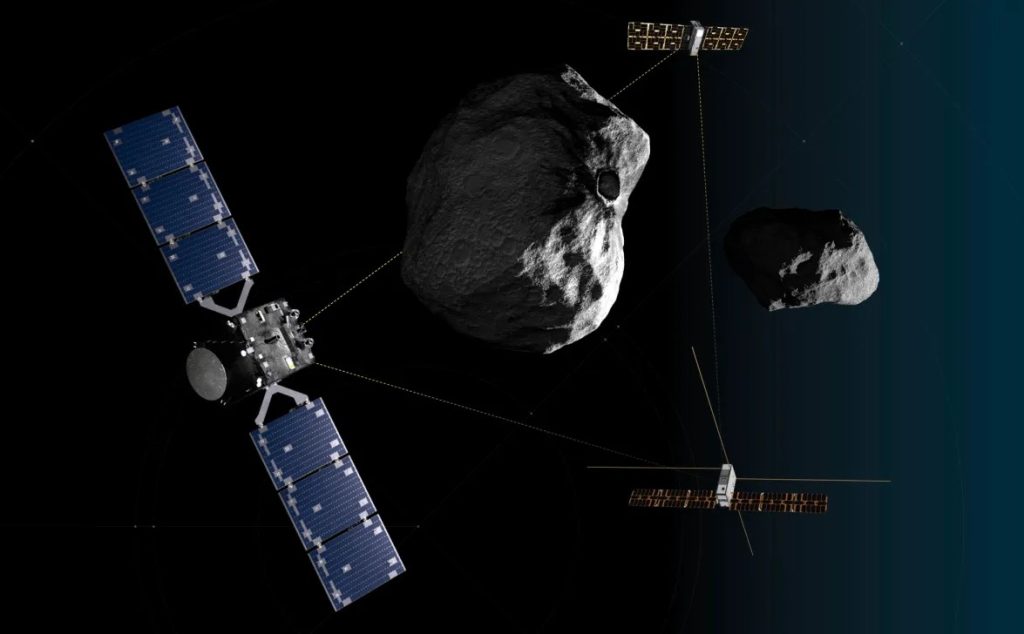WASHINGTON — The European Space Agency is proceeding with preparations for the launch of an asteroid mission on a SpaceX Falcon 9 even though the rocket remains grounded after an upper-stage anomaly on its most recent flight.
At an Oct. 2 briefing, officials involved with the Hera asteroid mission said they are continuing with preparations to be ready for a launch on a Falcon 9 from Cape Canaveral on Oct. 7 at 10:52 a.m. Eastern. That includes encapsulating the spacecraft into the rocket’s payload fairing on Oct. 3.
That work continues even though the Falcon 9 has been grounded since an incident at the end of its most recent launch Sept. 28. SpaceX said an “an off-nominal deorbit burn” by the upper stage caused the stage to reenter outside of a designated zone in the South Pacific Ocean. “We will resume launching after we better understand root cause,” the company stated.
SpaceX has not provided additional details or updates about the incident or investigation. Elon Musk, the chief executive of SpaceX who has previously shared information about company activities, including during the previous upper stage anomaly in July, has been uncharacteristically silent on the topic on X, the social media network he also owns, despite actively posting on other topics.
The FAA, in a Sept. 30 statement, confirmed that it was requiring SpaceX to perform an investigation into the anomaly. That investigation need not be completed before the company can resume launches if the FAA determines that public safety is not affected.
At the ESA briefing, Ian Carnelli, project manager for Hera at ESA, said the mission is getting daily updates on the status on the investigation. “We are very happy with the progress they are showing to us, which proves their commitment to launch us,” he said. “We are maintaining the nominal launch campaign.”
“We will be ready to launch” on Oct. 7, he said, pending approval from the FAA to allow Falcon 9 launches to resume. “We are basically hoping we get it by Sunday [Oct. 6].” He added that ESA is willing to have Hera be the return-to-flight mission for the Falcon 9, rather than wait for SpaceX to launch one or more missions, such as those carrying Starlink satellites, first.
The launch period for Hera runs through Oct. 27, with daily instantaneous launch windows. Carnelli said NASA has requested a 48-hour standdown ahead of the launch of Europa Clipper on a Falcon Heavy at the Kennedy Space Center, currently scheduled for Oct. 10.
A launch any time in that window will allow Hera to reach its destination, the asteroid Didymos and its moon Dimorphos, at the end of 2026. That asteroid system was previously visited by NASA’s Double Asteroid Redirection Test (DART) spacecraft, which collided with Dimorphos in 2022 to change its orbit as a demonstration of a planetary defense technique to change the trajectory of a potentially hazardous asteroid.
Hera will characterize the asteroids in the aftermath of that impact. “The first thing is to find out how efficient the impact was,” said Michael Kueppers, Hera project scientist, at the briefing. Scientists want to know how much momentum was transferred from the spacecraft impact to Dimorphos, as well as additional push provided by debris ejected from the asteroid. Measuring the mass of Dimorphis, he said, will help them calculate that efficiency.
Hera will also observe the surface of Dimorphos to see what kind of crater or other surface changes the DART impact caused. “We will learn a whole lot about how the impact process works,” he said. “Apart from the scientific interest, this is highly valuable if we want to apply the technique in a real case.”
Hera is equipped with 12 instruments. It will also deploy two cubesats, ESA’s first deep-space cubesat missions. Those cubesats could allow closeup observations of the asteroids if Hera finds that there remains a dangerous cloud of debris in the vicinity of the asteroids left over from the impact, said ESA flight director Ignacio Tanco.
The Hera mission has a final confirmed cost of 363 million euros ($401 million), which came in below estimates. Carnelli said that budget performance freed up 20 million euros to begin work on Ramses, a mission to visit the asteroid Apophis before it makes a close Earth flyby in 2029. Ramses will be a “stripped-down” version of the Hera spacecraft with a single-string architecture, he said.
“Nobody believed we were going to make it,” he said, recalling discussions at the 2016 ESA ministerial conference where ESA members rejected an earlier version of Hera, called the Asteroid Intercept Mission. ESA approved Hera at the next ministerial in 2019, but with a tight budget and schedule.
The delay in approving the mission, Carnelli said, was a benefit, allowing the team more time to “prepare properly” for it, getting prime contractor OHB and its various subcontractors — which include Avio, GMV, Redwire, Spacebel and Thales Alenia — in place. The mission also weathered the Covid pandemic and subsequent supply chain problems.
“The fact that we had a very strict launch window, I think, pushed every single supplier to do their best,” he said. “It really was an amazing project and I can only be extremely proud of what we have achieved together.”

